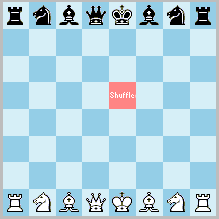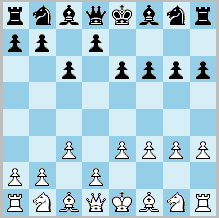

The opening setup for the pawns is chosen randomly while satisfying the condition that the pawns must be placed either on the second or the third rank. There are 256 possible configurations. All of them are sound and balanced, and fully playable. Black's setup mirrors white's. In all other respects this game is the same as orthodox chess. The opening setup for the pieces on the first rank is the same as in orthodox chess. This is convenient, as chessplayers will feel immediately at home.
Randompawns Chess was created as an answer to the problem of opening monotony in standard chess, which threatens to stifle spontaneous creativity in chess. The pawn army is the soul of the chessboard, and the strategical aspects depend strongly on the setup of the pawns. Such variability arouses enthusiasm for the game, unlike the tedium of opening study in orthodox chess. The randomization of the pawn chain implies a thorough kill of opening theory (except in one case of 256).
Normal chess principles apply. It is important to take into account weaknesses and strengths in the pawn chain when deciding for a plan. While some pawns are initially placed on the third rank, the resultant positions should give black a slightly easier game than in the standard position. This variant could be ideal for chess training. It is easy to generate the pawn positions randomly. Simply toss a coin eight times, once for each pawn pair. Of course, this program, as well as the free DOS program below, could be used as a random generator.
 Example of a position after shuffle is performed.
Example of a position after shuffle is performed.
• You can download my free Chess256 program here (updated 2007-01-03), but you must own the software Zillions of Games to be able to run it (I recommend the download version).
• Another program that supports Chess256 is BlindChess (DOS freeware).
• Try playing Chess256 by e-mail, against a human opponent, here. (This script also works as a random generator.)
• Don't miss my other chess variants.
© M. Winther 2006